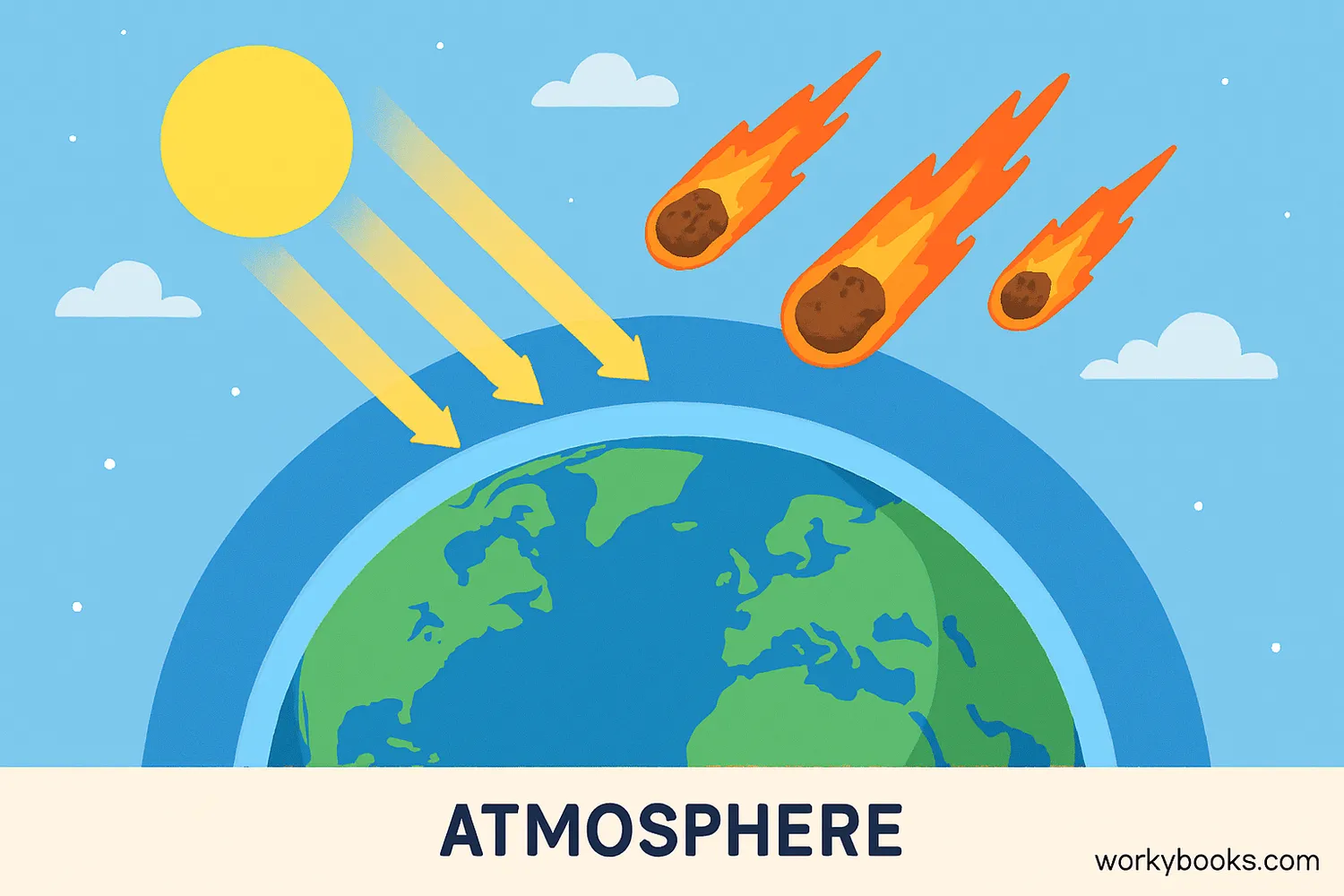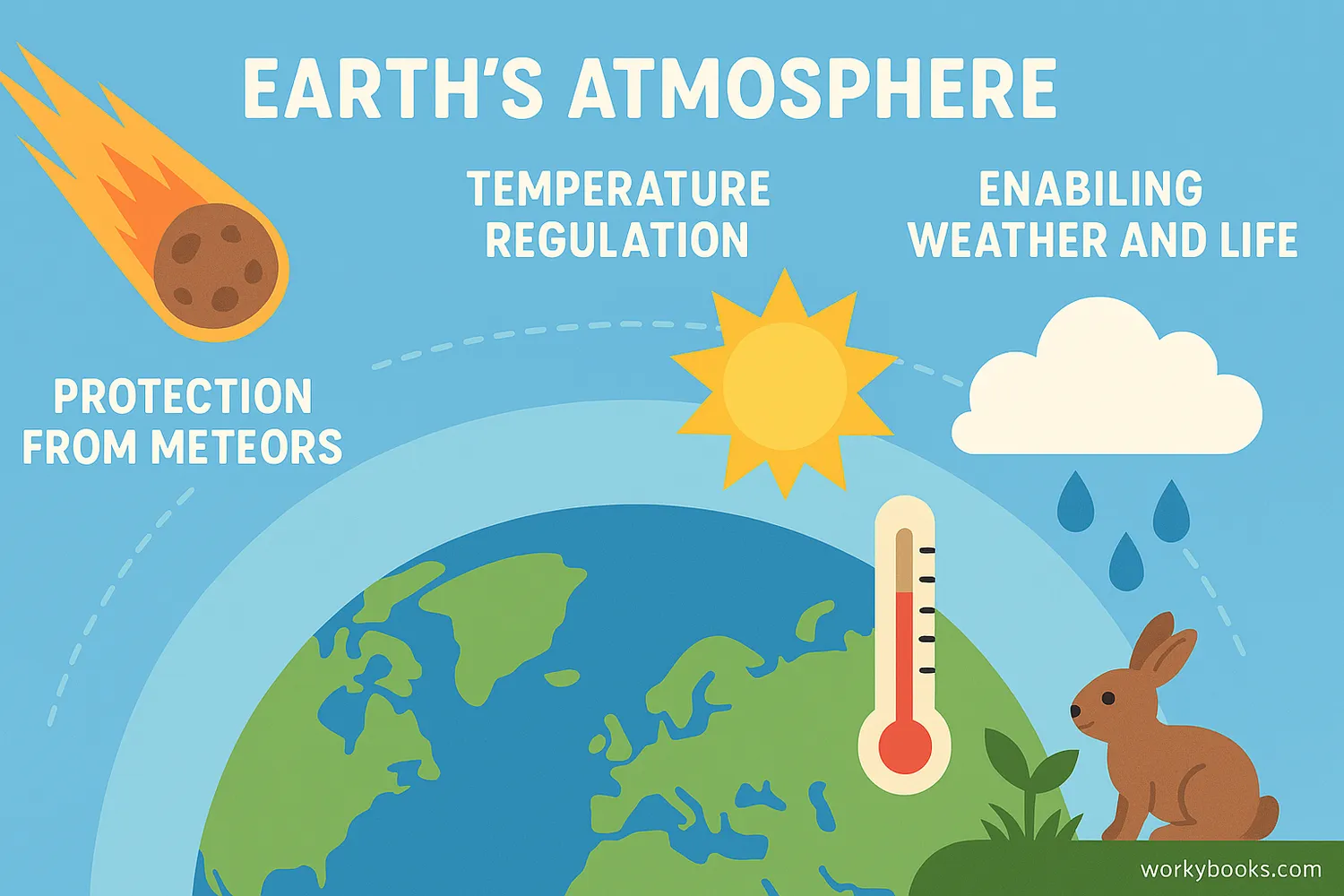Atmosphere - Definition, Examples, Quiz, FAQ, Trivia
Discover the protective layer that makes life on Earth possible
What is the Atmosphere?

The atmosphere is the layer of gases that surrounds our planet Earth. It's like a protective blanket that wraps around our world, held in place by gravity.
Think of the atmosphere as Earth's security system! It protects us from harmful space radiation, burns up most meteoroids before they can hit the surface, and keeps our planet at just the right temperature for life to exist. Without our atmosphere, Earth would be as barren and lifeless as the Moon.
Atmosphere Fact!
The atmosphere extends about 10,000 kilometers (6,200 miles) above Earth's surface, but most of it is within 16 kilometers (10 miles) of the surface.
Layers of the Atmosphere

Earth's atmosphere is divided into five main layers, each with its own special characteristics. As you go higher, the air gets thinner and the temperature changes in different ways.
Troposphere
Where we live and weather happens (0-12 km)
Stratosphere
Contains the ozone layer (12-50 km)
Mesosphere
Where meteors burn up (50-85 km)
Thermosphere
Where auroras occur and space shuttles orbit (85-600 km)
Exosphere
Outer layer where atmosphere merges with space (600+ km)
Each layer has an important job. The troposphere contains the air we breathe and where weather occurs. The stratosphere contains the ozone layer that protects us from harmful UV radiation. The mesosphere protects us from meteors. The thermosphere is where auroras happen, and the exosphere is where satellites orbit Earth.
Altitude Fact!
Commercial airplanes typically fly in the lower stratosphere to avoid weather disturbances that occur in the troposphere.
Atmospheric Composition
Earth's atmosphere is made up of a mixture of gases. The two most abundant gases are nitrogen and oxygen, which together make up about 99% of clean, dry air.
Nitrogen (78%)
The most abundant gas; important for plant growth
Oxygen (21%)
Essential for animals to breathe and for burning fuels
Other Gases (1%)
Includes argon, carbon dioxide, and trace gases that have important roles
The atmosphere also contains water vapor (humidity), which can be as much as 4% of the atmosphere in some places. Other important gases include carbon dioxide, which plants use for photosynthesis, and ozone, which protects us from ultraviolet radiation.
Greenhouse gases like carbon dioxide, methane, and water vapor help trap heat in our atmosphere, keeping Earth warm enough for life. However, human activities are increasing the amount of these gases, which is causing changes to our climate.
Importance of the Atmosphere

Earth's atmosphere is essential for life as we know it. Without it, our planet would be very different and unable to support the diverse life forms we see today.
Temperature Regulation
Keeps Earth at a comfortable average temperature of 15°C (59°F)
UV Protection
The ozone layer absorbs harmful ultraviolet radiation from the Sun
Meteor Protection
Burns up most meteoroids before they reach Earth's surface
The atmosphere also enables weather patterns that distribute heat and moisture around the planet. It provides the air we breathe and allows sound to travel. The atmosphere even helps moderate the temperature differences between day and night.
Without our atmosphere:
• There would be no breathable air
• Temperatures would swing wildly between extreme heat and cold
• Harmful radiation would reach Earth's surface
• Liquid water would evaporate into space
• There would be no weather or blue sky
Protection Fact!
The atmosphere protects us from about 100 tons of meteoritic material that hits Earth every day, burning up most before it reaches the surface.
Atmosphere Quiz
Test your knowledge about Earth's atmosphere with this quiz! Answer all 5 questions to see how much you've learned.
Frequently Asked Questions
Here are answers to some common questions about Earth's atmosphere:
Interesting Atmosphere Facts
Discover some amazing facts about Earth's atmosphere!
Surprisingly Thin
If Earth were the size of an apple, the atmosphere would be about as thick as the apple's skin! Most of our air exists in a very thin layer relative to Earth's size.
Heavy Air
The total weight of Earth's atmosphere is about 5.5 quadrillion tons! That's equivalent to the weight of 5.5 billion Empire State Buildings.
True Color
If we could see all the molecules in the air, the atmosphere wouldn't look blue. It's actually mostly transparent—the blue color comes from how light scatters in the air.
Defining Space
The Kármán line at 100 kilometers (62 miles) above sea level is internationally recognized as the boundary between atmosphere and space.


